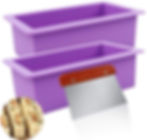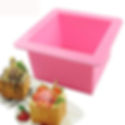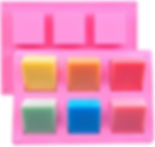
As beginner soap makers, we quickly learn how wonderful and amazing the soap making process is. For those who take the time to learn the fundamentals of soap science, recipe formulating, design, and process, like those who have read The Ultimate Guide to Soap coursebooks, the learning process is much smoother and filled with fewer complications, making it a fun and easy adventure. In online soap making groups, you will often see soap makers make jokes like “Hello. My name is Ashley, and I am a Soap Addict” or post an image of an entire room full of brand new soap making supplies with a comment that says, “I am wondering how much more I can fit?" Soap making is a wonderful and amazing hobby, but it is important to note that there is a “smart” way to “get soap crazy” and a “not-so-smart” way to get in over your head.
One of the easiest ways to make smart decisions about your soap production process (in addition to obtaining knowledge and skills from UG2HP/UG2CP), is to select the appropriate batch size and use tools created for beginners. Let’s explore how “less soap” can actually provide you with “more,” and how small-batch soap making can actually make you a more informed, experienced, and efficient soap maker.
A popular soap mold option that is loved by soap makers around the world is called a loaf mold. This style of soap mold provides an endless possibility of different design options, including layering, drop swirls, hanger swirls, textured tops, and more. Loaf
molds are also a popular mold choice used by professional soap makers because they can be easily used to make large batches of soap, a process commonly called masterbatching in the soap making community.
Unfortunately, one of the most common mistakes we see beginners make is the use of these professional-size loaf molds, which results in the production of professional/larger sized soap batches, ranging from 10-30 bars per batch. As a beginner, you are still learning the fundamentals of soap science and recipe formulating, and you are developing your skills as a soap maker. You might also be testing new design techniques, additives, fragrances, and more. During times of learning and testing, it doesn’t seem logical to invest in and create five pounds of soap for each test batch.
We see many beginners purchase a specific 3.5lb wood mold with a purple or pink silicone liner from Amazon/Ebay because it is a budget-friendly loaf mold. Although these molds are perfect, affordable, reduce waste, and are easy to use (we have
dozens of them in our studio), they are not the best molds for beginners, and we do not recommend them for use by novice soap makers. The use of larger soap molds, combined with a beginner’s inexperience and a lack of quality research and education, can lead to some very costly and disappointing results.
As teachers and administrators of several online soap making groups, we see hundreds of beginners post weekly images of soap complications in this particular wood/silicone loaf mold and other larger mold options just like it. When purchasing supplies in smaller amounts, a 3-5lb mold can contain between $10-$50 worth of raw materials. When complications arise, which are common occurrences for beginners and those who have not thoroughly researched the science of soap making, this large-batch complication becomes an emotionally devastating and dreadfully expensive problem.
The use of larger recipe and mold sizes also creates another “problem” that beginners experience-LOTS of soap! Although soap production is obviously one of the benefits of soap making, and the reason why we make soap in the first place, it can also be a downside too. Beginners who use large soap molds and enjoy making soap (who doesn’t like making soap?!) often end up with huge piles of extra soap. A standard 10-inch loaf mold, like the one most soap makers purchase from Amazon, makes on average 10-12 bars per batch. If you make three batches of soap in one day, you are creating 36 bars of soap. Now imagine how many bars of soap you will make over the course of a few months. Hint- the answer is hundreds!
This excess of soap, in addition to the huge costs required for large-batch production, causes many novice soap makers to believe that they should start selling their soap, even if it is only to support their habit, err, I mean hobby (😊). Because of this, beginners with little to no experience are opening shop and selling their extra soap after as little as one to two batches, even if their recipes have not been properly formulated and may include poor soap qualities, an increased risk of oxidation, and other common beginner mistakes.
Side note: Selling soap, a cosmetic product that is applied to the skin and made from caustic ingredients, is a professional responsibility and one that should not be rushed into or taken lightly. We recommend a minimum of 6-12 months intensive education, research, experimentation, and expertise in soap making and recipe formulating, in addition to time spent learning the business side of selling soap, which is about 80-90% of a handcrafted soap business, including things like marketing, accounting, local, state and federal laws, taxes, and more. With more than 350,000 handcrafted soap makers in the United States alone, we promise that taking the time to enjoy the learning process will not only make your products better, but you will also benefit by becoming a better and more successful business owner.
For those who are new to soap making and are still in the process of early learning and exploration, we do not recommend the creation of large batches or the use of professional sized molds. These require sizeable amounts of supplies, a pricey investment in materials, and limit the soap maker in skills and experience. Instead, we recommend that beginners and those who are testing new recipes/designs/additives begin with small batches that use no more than 500g of oil, or around sixteen ounces or one pound.
The use of a smaller loaf mold will still allow you to reap the design benefits a loaf mold has to offer, while reducing the risks and cost, and increasing your skills, knowledge, and experience. A small loaf mold will use approximately half the materials that a standard 10-inch loaf mold requires and creates 4-6 full-size bars. The use of a smaller loaf mold also provides soap makers with the opportunity to test new recipes, colorants, fragrances, additives, and more, without breaking the bank or risking a financial and emotional crisis.
If a balanced and informed recipe is used, a single bar of soap should last a minimum of six weeks per bar with individual use. Four to six full-size bars made from a balanced and informed recipe will last an individual several months! Unless you are gifting or selling your soap, which should not be done as a beginner or with experimental batches, we do not feel that it is necessary to fill a 3-10lb loaf mold every time that you want to enjoy your hobby of soap making.
As you can see, there are certainly some benefits to using smaller batch sizes- knowledge, experience, recipe and additive testing, reduced costs, design practice, and more. Sometimes making LESS provides MORE.
While there are certainly TONS of single cavity mold options that come in all different shapes, sizes, and design, I personally prefer to make my soap in loaf molds. Although we use larger loaf molds for our donation soaps, when I try new recipes or feel like “playing soap” and enjoying my hobby, even after making and teaching soap
making for years, I still use small-batch loaf molds.
Below you will find three of my favorite smaller loaf molds that I personally own and use. They are also the molds that we use in our intensive beginner classes and the molds we recommend to our students. These are all under $10 and part of Amazon Prime, so you are still getting a budget mold, with free two-day shipping if a Prime member or placing an order over $25. Click to shop and get yours today!
For those who want to work with single-cavity molds or make even smaller batches, these are some other great affordable options and some of my personal favorites.








